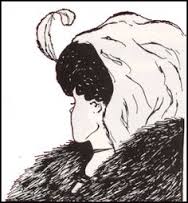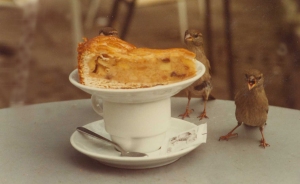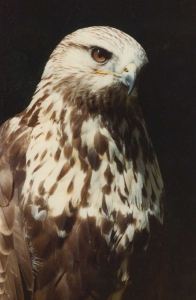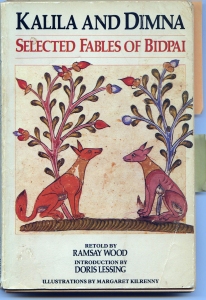Try and shut your eyes to slits and blink through autumn branches against the light. With patience, a  moment arrives when black and white spaces inverse and clusters of stars shine from another dimension. The background has moved to the foreground. A tiny shift in our outlook can result in a new interpretation of what we see, like in the gestalt drawing on the right, which changes the age of the person if you let your eyes wander up and down the image. Visual tricks that open a sudden gap in our seeing reveal how we jump to superficial referencing. Making snap assessments is convenient, safes time, energy, and sometimes lives, but can also trap us in a kind of flatland of rigid divisions.
moment arrives when black and white spaces inverse and clusters of stars shine from another dimension. The background has moved to the foreground. A tiny shift in our outlook can result in a new interpretation of what we see, like in the gestalt drawing on the right, which changes the age of the person if you let your eyes wander up and down the image. Visual tricks that open a sudden gap in our seeing reveal how we jump to superficial referencing. Making snap assessments is convenient, safes time, energy, and sometimes lives, but can also trap us in a kind of flatland of rigid divisions.
What do we mean when we say he or she is different – do they look different, act different, think different, or have customs that seem strange to us? Typical brackets are class, gender, cultural background, colour, language, age, ability … and migrants. Defining people by categories clicks in as a default opinion when real or imagined threats require scapegoats. Or resources are scare and solidarity is politically expedient. Suddenly the need to belong and historical prejudices reasserts themselves.
Beneath all habitual categories prowls what is frequently forgotten … the inherent natural tendency of each individual. Consider relatives, neighbours, familiars, friends and foes. The differences that delight or irritate us lie foremost in a person’s unique temperament and inherent tendencies. Background does not explain the mystery of characteristics we are born with, the random mix of evolutionary records in our bodies, a wisdom our minds expand upon through resonance with the collective psyche – a shared matrix of past experience and future potential from which we, ideally, emerge as a self-reflective persona. (The theory of a collective unconscious and similar non-evidenced theories relate to my experience.)
irritate us lie foremost in a person’s unique temperament and inherent tendencies. Background does not explain the mystery of characteristics we are born with, the random mix of evolutionary records in our bodies, a wisdom our minds expand upon through resonance with the collective psyche – a shared matrix of past experience and future potential from which we, ideally, emerge as a self-reflective persona. (The theory of a collective unconscious and similar non-evidenced theories relate to my experience.)
Environmental factors can distort the unfolding of latent knowledge in every living organism. Education has a detrimental effect on children when their intuition is belittled and their minds are flattened with facts before they developed the confidence to question these facts.
 How come I’m invigorated by rushing waters, calmed by a smooth stone, a golden sunset? How do I sense the pulse in a tree, or what life is like for a boar, rat, ox, tiger, rabbit, dragon, snake, horse, sheep, monkey, rooster, dog – unless all nature’s qualities also reside in me?
How come I’m invigorated by rushing waters, calmed by a smooth stone, a golden sunset? How do I sense the pulse in a tree, or what life is like for a boar, rat, ox, tiger, rabbit, dragon, snake, horse, sheep, monkey, rooster, dog – unless all nature’s qualities also reside in me?
For example, anyone who sits in a public place and watches people stroll by will notice traces of animal features; can spot a temperament in gestures and movements, observe someone dragging their body behind their head, or push their belly out like a shield. Some people dance along with a fluid gait, while others tiptoe and glance nervously about them.
 At social gatherings we may come upon clusters of meerkats grooming each other, turtles plodding through the crowd looking for a mate or a fresh salad leaf, peacocks, obsessed with their splendour, blustery cockerels, loving old dogs, sharp-eyed falcons, enchanting robins, and so on. …
At social gatherings we may come upon clusters of meerkats grooming each other, turtles plodding through the crowd looking for a mate or a fresh salad leaf, peacocks, obsessed with their splendour, blustery cockerels, loving old dogs, sharp-eyed falcons, enchanting robins, and so on. …

Birds are keen on cake but wary of cats, whereas lions can afford to be relaxed. How amazing then to observe vastly different temperaments complementing each other – like a person  with a butterfly nature tying up with a partner who occasionally roars. Given the rich lore of sensibilities mixing and battling in the human psyche, strangers should be less strange than we make them out to be.
with a butterfly nature tying up with a partner who occasionally roars. Given the rich lore of sensibilities mixing and battling in the human psyche, strangers should be less strange than we make them out to be.
Initial likes and dislikes, even among kin, have nothing to do with background, morals or ethics. Wariness goes along with fascination when it comes to difference. We may not be keen to share a nest, but sharing a street is fun. Nature is a mirror that teaches us how to become human. And animals deserve our special appreciation for reminding us of the innumerable diverse idiosyncrasies in ourselves.
Animals have appeared in wonderful stories around the world, like the Aesop’s Fables or the much older Indian Panchatantra Collection – the chief source of the world’s fable literature.
 The Persian translation became the Fables of Bidpai. Lovely collections of Kalila and Dimna were published by Ramsey Wood, one with an introduction from Doris Lessing. I got permission from Ramsay Wood to use a short tale from his collection in my novel ‘Course of Mirrors.’
The Persian translation became the Fables of Bidpai. Lovely collections of Kalila and Dimna were published by Ramsey Wood, one with an introduction from Doris Lessing. I got permission from Ramsay Wood to use a short tale from his collection in my novel ‘Course of Mirrors.’
Programmes on ‘Respecting Difference’ have made it into schools and institutions. But can respect be taught in a few hours? More effective are courses that help people to find self-respect through exploring the diverse feelings and judging voices within themselves, the inner conflicts that manifest for us outside.
Acknowledgement, at least, tolerance and patience with our inner crowd eases snap projections and allows us to rediscover ourselves in the eyes and minds of others day by day. The internet expands this mirroring into timeless realms, from where echoes of our own dissonance or resonance return.
In the analogue world people are on the move across the planet – for various reasons – war – drought – famine – persecution – fresh meaning – it is happening, and it will continue. The most productive response to this phenomenon is to embrace its creative potential.
The other day woke up with this thought: Migrants, indeed all citizens sans resources but able and willing to work, could be given the spaces to create new towns, be empowered to build their own houses and develop their own businesses, and conducts, as a way towards gaining self-respect, and in addition contribute to the well being of a community. Maybe this is a naive pipe dream, but worth contemplating nevertheless, since creative opportunities nurture self-respect and move us beyond self-concern.
‘The whole is other than the sum of the parts … it has an independent existence.’ – Kurt Koffka
Related links
More contagious than micro-organisms are fear and hopelessness.
Have you ever gone to your fridge in the middle of the night …
Pattern which connects – Gregory Bateson
Regarding the discovery of what we know, see the visionary work, Involution, by Philippa Rees, a remarkable poetic adventure, with brilliantly researched additional historic commentaries. A book to take on a Desert Island.

Some fine writing in those middle paragraphs (5, 6, 7) – where the piece comes alive. Good voices, voicing.
LikeLiked by 1 person
Thanks Joe, good to have feedback.
LikeLike
can’t make the drawing change for me – sigh. never mind it was an interesting and thought provoking piece.
LikeLiked by 1 person
Can you describe what you see Diane?
LikeLike
a side views of a very young woman in a fur and a rather unusual hat
LikeLiked by 1 person
You make me think of one aspect in the picture that seems to be there mainly to confuse the eye, the frivolous feather-like object on top. It might help to cover it up.
LikeLike
So many layers could be teased out from this post. First thank you for the ‘heads up’ on Involution. Yet all you say here reflects what is in that! I SO endorse the animal contributions to body language which ( political correctness set aside) is undeniable. THE most trustworthy source of knowledge and judgement!
Your idea of new opportunities for self reconstruction by migrants is one I share. Trying to ‘help’ diminishes. Offering a chance help-self is another thing altogether! Yet the do-gooding world would never trust enough to let it happen. Even Syrian refugees MUST be settled in towns where they can walk to ‘services’ not in my garden where they would have to get a driving licence. One despairs.
LikeLike
My pleasure, Philippa. Your work endlessly gives of its treasure ☼
Is it true you have a dog again? a Puppy?
Isn’t it strange how societies considering themselves civilized fail to appreciate animals properly, or see how their qualities operate in us. We owe everything to these most amazing and varied creatures.
I had forgotten you tried and failed to accommodate refugees. We receive by what we offer and give, and to have one’s offering and giving refused is an insult to the heart.
LikeLike
As we all may be slaves to our collective bias ( perhaps solidly formed through disease and hardship), it is difficult to transpose one’s ego to that of animals or birds. This also is the case in understanding fellow humans.
Interesting that we are all refugees at a point in life and require a safe place to rebuild, repair and renew. We are often given this privilege as a matter of course, but at other times ( should it cross our animal boundary) it is strongly denied.
Your idea of viewing life through the prism of another, exposes our collective and individualist tendencies. I guess we are guided and influenced from what kind of pasture we currently live on.B
LikeLiked by 1 person
Slaves, yes. Collective bias, in my understanding, is a kind of lazy economy, useful, even necessary at times, especially in our information saturated world, but dull, and lacking imagination.
Transposing one’s ego into animals … it’s deeper, below that construct. I sometimes feel the animal’s nature, it’s vital energy, in my body. I also connect to its archetype. My mysterious imagination 🙂
I need to think about you last para. Re: viewing life through the prism of another … something happens inside first of all.
LikeLike
I loved this post as you have provided great thought, insight, and description. I think we can learn from so much and so many in life. Too many people want life to be uniform and generic. I think we can learn so much from different cultures, lives, habitat, etc. Thanks for expressing you thoughts. I wish more people would learn from one another rather than fight one another.
LikeLiked by 1 person
Thank you Gwynn. I agree with you. Trouble is masses of people have too much pressure in their lives and no energy for contemplation and learning left, or just enough to listen to one radio wavelength – I mean that metaphorically.
LikeLike
As ever, a thought-provoking piece rich with wisdom, empathy and warmth. Thank you. I, too, often find animal traits in humans. Not just a physical resemblance but emotional/mental characteristics. No wonder Aesop and Krilov wrote fables, satirising humans by through animal characters!
LikeLiked by 1 person
Thanks Katia. Genau – emotional and mental characteristics as well. I sense animals as a constant eternal presence in us.
LikeLike
Thanks Ashen, a great post. I’m familiar with the first picture and USED to be able to see two pictures in the one – but right now I’m not getting it and I can’t remember what is what that I USED to see 🙂 – both the fur-clothed young woman and an old woman? Never mind.
Yes, we do ourselves a disservice to remain within our limited lens –
May it not be a pipe dream for migrants to empower themselves, ie without handouts.
‘The whole is other than the sum of the parts … it has an independent existence.’ I love this quote by Kurt Koffka.
LikeLike
Thanks for your visit, Susan. May human insight enlighten our systems.
“Faith is a bird that feels dawn breaking and sings while it is still dark.”
– Rabindranath Tagore
LikeLiked by 1 person
“Birds are keen on cake but wary of cats, whereas lions can afford to be relaxed.” ~Some of the descriptions here are fantastic!
LikeLiked by 1 person
🙂 Thanks, Christy.
LikeLike
Embracing the creative potential would be fantastic, the only question is: do the migrating people want to create? Probably, the newer generations will have no problem with completely moving into the new conditions and life. However, I’m seeing in Canada how some do not want to integrate into society, but carry on without learning language, without understanding habits, traditions, life style, etc.
LikeLike
And Canada is one of the more enlightened societies. I don’t know how it would be made less scary to integrate. I only imagine if I had to flee for my life into a culture vastly different from the one I grew in, and feeling, while tolerated, not exactly welcome in the social sphere, it would take an almost superhuman effort to mingle and may even feel like a betrayal to one’s kin.
Which is where my idea of new communities kicks in, towards which people feel responsibility and ownership, because I think it’s easier to integrate a group that is allowed its integrity than risking single people or families to get divided among themselves.
LikeLike
Pingback: … political poker games … | Course of Mirrors
Pingback: … resurrected treasures – fables … | Course of Mirrors